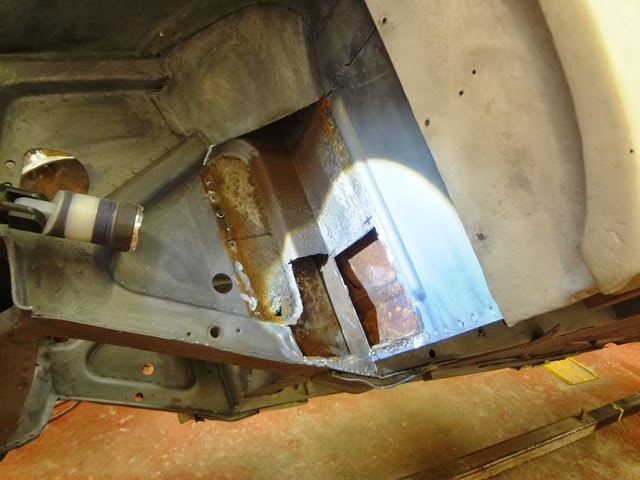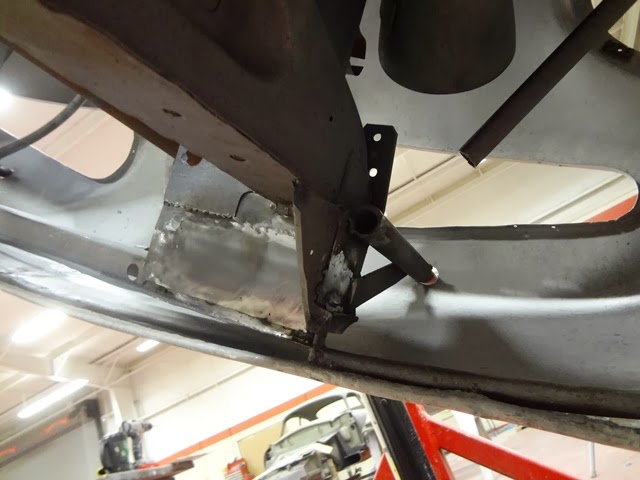VALVE trains, that is.
In previous posts I mentioned that the Alfatross' beating heart, its engine, is being restored in Phoenix under the direction of DeWayne Samuels, aided by various vendors of parts and services. The reassembly is taking place at Standard Machine in Phoenix under the supervision of proprietor Roger Lorton.
When I first looked under the hood of The Alfatross what I saw was a little weenie 4-cylinder engine disguising what I perceived at the time to be its inadequacies under an enormous air cleaner on the right side and and equally enormous shroud ducting air over the tubular exhausts.
Now that I have offended all you thousands of Alfa aficionados out there watching this blog, let me go on to apologize for my ignorance. I now know it is not the simple, unsophisticated lump I took it for 45 years ago, and the proof of that is the following treatise on the kind of diagnosis and surgery it is taking to restore it to health and vigor.
The following is DeWayne's diagnosis of what appears to be less than perfect with the valve train and what he is doing to correct it. These engine guys have a wide variety of tools and treatments they can bring to bear, and I think they have used just about all of them except the one advertised below:
When I first looked under the hood of The Alfatross what I saw was a little weenie 4-cylinder engine disguising what I perceived at the time to be its inadequacies under an enormous air cleaner on the right side and and equally enormous shroud ducting air over the tubular exhausts.
 |
| The enormous air filter and plenum chamber atop the Solexes covers the top of the engine on the right side. |
The following is DeWayne's diagnosis of what appears to be less than perfect with the valve train and what he is doing to correct it. These engine guys have a wide variety of tools and treatments they can bring to bear, and I think they have used just about all of them except the one advertised below:
 |
| A tool no car guy should be without. |
Cylinder Head
The valve train has a lot of individual components. DeWayne's diagnosis divides them into cylinder head and timing chest components. Those in the cylinder head are the valves, valve adjusters, cam followers, springs, valve guides, and camshafts. DeWayne says:Valve train issues include oiling problems resulting in accelerated wear damaging both camshafts and cam journals in the cylinder head, valve adjusters, cam followers, valves and guides. Don sourced new intake valves, but the exhaust valves are excessively worn on the stems and unusable due to repeated or excessive face grinding which depleted the face margin to zero. Exhaust valves are on order from Europe.
 |
| Original intake valves (left) and exhaust valves. Note how the margins of the exhaust valves are too thin for reuse. |
All the cam followers have been reconditioned by hard chroming the faces and creating the proper taper with Blanchard grinding to promote valve rotation. For an added measure they have been treated with a DLC (diamond like carbon) extreme pressure coating.Replacement guides were sourced but found unacceptable as they are only offered in a standard O.D. Because the receiving bores for the guides vary in diameter, we opted to machine custom guides from manganese bronze to offer the correct press fit for the proper dynamic tension within the bore of the cylinder head. Later the guides will be reamed and honed on the I.D. for the correct oil clearance for the valve stems.
Alfa Romeo 1900 valves are a thing of wonder, as in "I wonder why they did that?"
Timing Chest Components
DeWayne continues:
 Whew! That's a lot of replacement and repair for an engine that has only 110,561.4 km (about 66,000 miles) on it. To what extent it is the result of poor maintenance and neglect? Or could it suggest a racing history--something that has so far eluded us?
Whew! That's a lot of replacement and repair for an engine that has only 110,561.4 km (about 66,000 miles) on it. To what extent it is the result of poor maintenance and neglect? Or could it suggest a racing history--something that has so far eluded us?
Thanks, DeWayne and Roger!
Both timing chains are to be replaced as a time/maintenance service. Wear in the assembly is evidenced by the markings on each roller and the position of the chain tensioner being towards it’s outermost settings; additionally the upper chain has experienced side loading from the cams “walking” due to thrust wear issues and the tensioner bearing /shaft wear allowing side movement. Original new old stock chain sets were sourced for installation.
 |
| Front view of the engine showing the two timing chains, upper and lower, the tensioner for the upper chain, intermediate gear set. |
The intermediate gear set requires replacement of the bushings and restoring the pivot shaft by hard chroming and bringing back to original size. An overlying issue that prompted accelerated wear was discovered in cleaning: the oiling supply orifice was not fully drilled through, resulting in an extremely limited oil supply. Opening the circuit and hand detailing before and after hard chroming has corrected the problem.
The tensioner assembly also required restoration as the chain gear was worn by the improper alignment running due to the damage of the bearing and pivot shaft. The pivot shaft has been given the same service as the intermediate shaft. We still need to source a replacement bearing and tensioner gear to complete the assembly.
 Whew! That's a lot of replacement and repair for an engine that has only 110,561.4 km (about 66,000 miles) on it. To what extent it is the result of poor maintenance and neglect? Or could it suggest a racing history--something that has so far eluded us?
Whew! That's a lot of replacement and repair for an engine that has only 110,561.4 km (about 66,000 miles) on it. To what extent it is the result of poor maintenance and neglect? Or could it suggest a racing history--something that has so far eluded us?Thanks, DeWayne and Roger!














